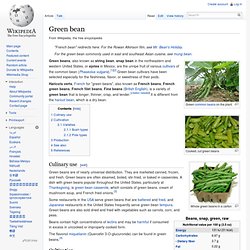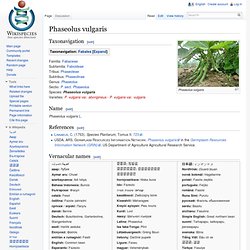

Gartenbohne. Eine Auswahl an Farben und Formen bei Gartenbohnen-Sorten Frisch keimende Gartenbohne Blüten einer Gartenbohne Merkmale[Bearbeiten] Gartenbohnen bilden unterschiedliche Wuchshabitus aus: determinate: buschbildend, begrenztes Wachstum, Vegetationspunkt endet am Hauptsproßindeterminate: buschbildend, kurzer Hauptsproß, Terminalknospe des Hauptsproß bleibt vegetativunbegrenzt wachsend, schwach rankend, langer Hauptsproßunbegrenzt wachsend, stark rankend abhängig von Standort und Tageslänge[3] Die Blüten stehen wechselständig zu mehreren in Trauben.

Die Keimung verläuft epigäisch, die dicken Speicher-Keimblätter kommen aus dem Boden und entfalten sich, sterben aber recht schnell ab. Die Chromosomenzahl beträgt 2n = 22.[4] Kulturgeschichte[Bearbeiten] Die Gartenbohne ist nur in Kultur bekannt. Während die nord- und mittelamerikanischen Wildsippen ebenfalls zu Phaseolus vulgaris gestellt werden, werden die wilden Verwandten in Südamerika zu Phaseolus aborigineus gestellt. Bihari Green Beans and Spinach Masala. This is a very free adaptation of a recipe I stumbled on while looking for something to do with a metric craptonne of green beans; I think of it as a sort of South Asian green beans almondine.

It was originally made as a side dish, but it would be a perfect dinner on its own with some spicy pickle, a pile of basmati rice, and maybe a handful of chickpeas thrown in if you're looking for some extra protein. The spinach was a last-minute addition because I wanted something properly green to balance the tempeh dopiaza it was accompanying, and the results were so pleasing that I highly recommend you do the same. (As for the cilantro, I find that it adds a certain "something," but haters can feel free to skip it or substitute something less objectionable.) Directions~ In a dry skillet, toast the almonds over medium heat until light golden. DISPLAY - GREEN BEANS. Green beans. Green Beans are Our Food of the Week This week we celebrate green beans, one of only a few varieties of beans that can be eaten fresh.

Picked when they are still immature and the inner bean is just beginning to form green beans are a great source of folate, fiber and vitamin K. For more on the Food of the Week What's New and Beneficial about Green Beans Because of their rich green color, we don't always think about green beans as providing us with important amounts of colorful pigments like carotenoids. WHFoods Recommendations To retain the maximum number of health-promoting phytonutrients and vitamins and minerals found in green beans, we recommend Healthy Steaming them for just 5 minutes.
Green Beans, cooked1.00 cup(125.00 grams) NutrientDRI/DV phosphorus5.1% This chart graphically details the %DV that a serving of Green beans provides for each of the nutrients of which it is a good, very good, or excellent source according to our Food Rating System. Health Benefits Cardiovascular Benefits. Green bean. Cooked, cut green beans Whole green beans in a carton Green beans, also known as string bean, snap bean in the northeastern and western United States, or ejotes in Mexico, are the unripe fruit of various cultivars of the common bean (Phaseolus vulgaris).[1][2] Green bean cultivars have been selected especially for the fleshiness, flavor, or sweetness of their pods.

Haricots verts, French for "green beans", also known as French beans, French green beans, French filet beans, Fine beans (British English), is a variety of green bean that is longer, thinner, crisp, and tender. [citation needed] It is different from the haricot bean, which is a dry bean. Culinary use[edit] Green beans are of nearly universal distribution.
Beans contain high concentrations of lectins and may be harmful if consumed in excess in uncooked or improperly cooked form. The flavonol miquelianin (Quercetin 3-O-glucuronide) can be found in green beans.[4] Phaseolus vulgaris. Phaseolus vulgaris, the common bean,[2] string bean,[3] field bean,[3] flageolet bean,[3] French bean,[3] garden bean,[3] haricot bean,[3] pop bean,[3] or snap bean,[3] is a herbaceous annual plant grown worldwide for its edible fruit, either the dry seed or the unripe fruit, both of which are referred to as beans.

The leaf is also occasionally used as a vegetable, and the straw can be used for fodder. Along with other species of the bean genus (Phaseolus), it is classified botanically into the legume family (Fabaceae), most of whose members acquire nitrogen through an association with rhizobia, a species of nitrogen-fixing bacteria. The common bean is a highly variable species with a long history of cultivation. Phaseolus vulgaris. Phaseolus vulgaris [edit] Familia: Fabaceae Subfamilia: Faboideae Tribus: Phaseoleae Subtribus: Phaseolinae Genus: Phaseolus Sectio: P. sect.

Phaseolus Species: Phaseolus vulgaris Varieties: P. vulgaris var. aborigineus - P. vulgaris var. vulgaris Name[edit] Phaseolus vulgaris L. References[edit] Linnaeus, C. (1753). Vernacular names[edit] Phaseolus vulgaris (Kidney bean) (French bean)